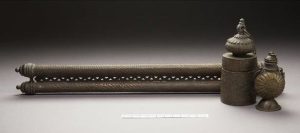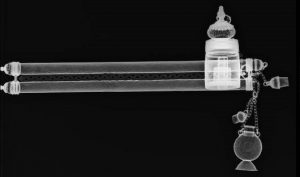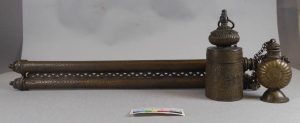Inkwell
Object

The object is a brass inkwell with connected pen box and flask. The object likely originated from North India, possibly during the Mughal Empire. Each of the parts have detachable lids to allow access to each component.

The inkwell is in two parts: the body and the lid. The body is attached to the pen box with a strip of metal and is decorated in bands of floral motifs incised into the metal. The lid is rounded and leads to a point at the top with an opening for a loop. Through the opening, a loop is attached with a chain connected to the pen box. The lid is decorated with an incised petal-like design radiating from the pointed top. The rounded design of the inkwell lid may be symbolic of the top of a mosque, making the object religious in nature.

Condition
- The object is covered in a layer of museum dust/dirt
- There is evidence of a layer of tarish on the surface of the inkwell
- The object shows signs of old polish residue in the crevices.
Conservation

The object was cleaned with a solvent appropriate for use on metals, applied by rolling cotton wool swabs over the surface. This removed all museum dust and dirt from the exterior of the inkwell; the solution was not used on the interior. Cleaning of the metal strip revealed an incised geometric design on one side.
Several abrasion methods were tested on copper coupons for tarnish removal; glass microballoons in ethanol was the most controllable and effective method tested. As such, this method was attempted on evening the tarnish on the flask but appeared to abrade immediately down to the bare metal with barely any application. This indicated that what appeared to be tarnish was not and may have been ink staining, which was original to the object and so it was left.

To remove the polish residue concretions, poultices of ethanol were applied as they were believed to be safe for the object. However, extended exposure to the ethanol resulted in taking off small parts of a varnish that appeared to be original to the piece; this varnish had not been known about prior to treatment. Isapropynol was then applied by repeatedly swabbing with cotton swabs to wet the concretions without prolonged exposure. Once softened, they could be removed mechanically with wooden tools to prevent scratching.

Areas with concretion removal had very bright brass-coloured metal underneath and the area that had been abraded on the flask had a reddish gold appearance, both of which were visually distracting from the darker brown patina. The exposed areas of the decorative strip and flask were coated with 10% Paraloid B-72 in acetone with 3% matting agent, burnt umber, and raw umber pigments added in to restore visual cohesiveness and protect the exposed metal. The areas in the lid with concretion removal were unable to be coated as they could not be fully reached and partial coating could have been problematic.
Additionally, areas where the varnish had been removed appeared matte and were also distracting. These areas were also coated with 10% Paraloid B-72 in acetone with 3% matting agent to restore visual cohesiveness.
